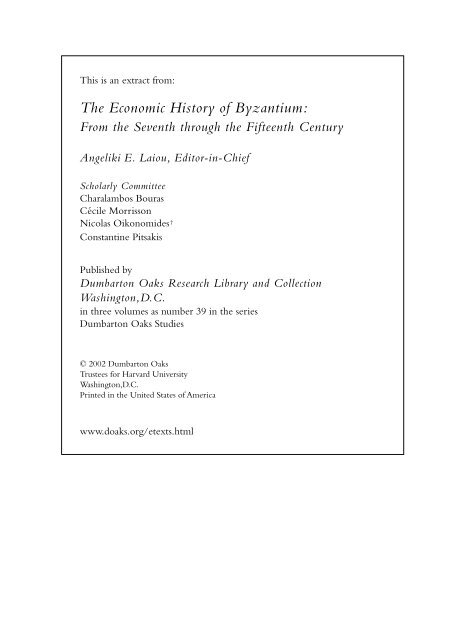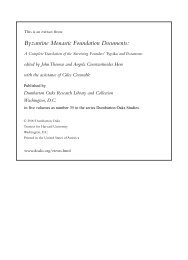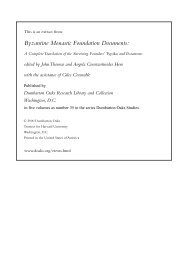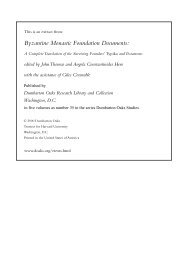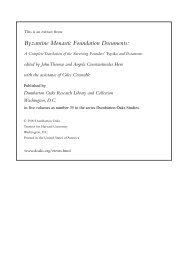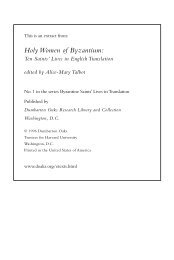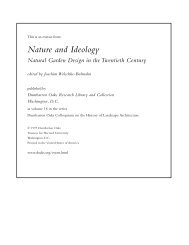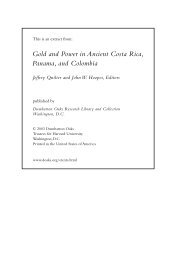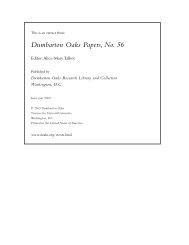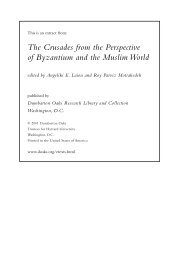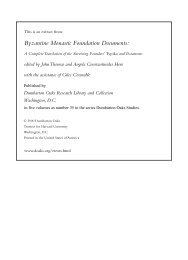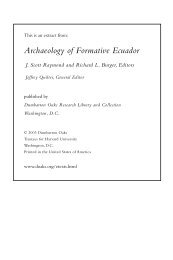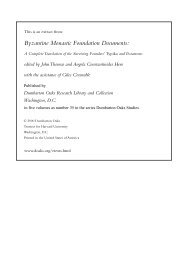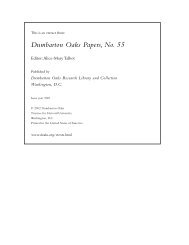The Human Resources - Dumbarton Oaks
The Human Resources - Dumbarton Oaks
The Human Resources - Dumbarton Oaks
You also want an ePaper? Increase the reach of your titles
YUMPU automatically turns print PDFs into web optimized ePapers that Google loves.
This is an extract from:<br />
<strong>The</strong> Economic History of Byzantium:<br />
From the Seventh through the Fifteenth Century<br />
Angeliki E. Laiou, Editor-in-Chief<br />
Scholarly Committee<br />
Charalambos Bouras<br />
Cécile Morrisson<br />
Nicolas Oikonomides †<br />
Constantine Pitsakis<br />
Published by<br />
<strong>Dumbarton</strong> <strong>Oaks</strong> Research Library and Collection<br />
Washington,D.C.<br />
in three volumes as number 39 in the series<br />
<strong>Dumbarton</strong> <strong>Oaks</strong> Studies<br />
© 2002 <strong>Dumbarton</strong> <strong>Oaks</strong><br />
Trustees for Harvard University<br />
Washington,D.C.<br />
Printed in the United States of America<br />
www.doaks.org/etexts.html
<strong>The</strong> <strong>Human</strong> <strong>Resources</strong><br />
Angeliki E. Laiou<br />
In the Byzantine Empire, as in all preindustrial societies, perhaps the single most important<br />
economic resource was manpower. Land without labor was useless, as contemporaries<br />
fully realized. 1 Arecognition of this fact may underlie the willingness of some<br />
people, most notably Plethon, to consider land a common resource, not to be bought<br />
or sold, and becoming valuable only through the labor invested in it. 2 In the chapters<br />
that follow, it will be seen that, given the slow advances of technology, demography is<br />
of primary importance in the development of the countryside, production being a<br />
function of the increase or decrease in population. 3<br />
Given this overriding importance of the human factor, it is particularly unfortunate<br />
that it is not possible to estimate with any degree of accuracy the population of the<br />
empire at any point in its history, at least after the sixth century. Efforts have, of course,<br />
been made, but the figures that have been proposed vary widely. 4 In 1949, E. Stein<br />
gave the figures 30 million in the reign of Justinian, 20 million in the first half of the<br />
eleventh century, 10–12 million under the Komnenoi, and 5 million during the reign<br />
of Michael VIII, without discussing the basis for these figures. 5 <strong>The</strong> figures most frequently<br />
cited are those of J. C. Russell, who proposes, for the eastern Roman and Byzantine<br />
Empire, a population of ca. 24 million in 350, 21 million in 600, 10 million in<br />
800, 13 million in the year 1000, and 7 million in the year 1200. 6 <strong>The</strong>y are, unfortunately,<br />
based on untestable assumptions, such as the proportion of the population of<br />
1<br />
See the statement of Constantine Limpidaris to Charles of Valois in 1308: A. E. Laiou, Constantinople<br />
and the Latins: <strong>The</strong> Foreign Policy of Andronicus II, 1282–1328 (Cambridge, Mass., 1972), 343.<br />
2<br />
See A. E. Laiou, “Economic Thought and Ideology,” EHB 1119.<br />
3<br />
Cf. J. Lefort, “<strong>The</strong> Rural Economy, Seventh–Twelfth Centuries,” EHB 261ff, and A. E. Laiou,<br />
“<strong>The</strong> Agrarian Economy, Thirteenth–Fifteenth Centuries,” EHB 306ff.<br />
4<br />
For adiscussion of older efforts, and a critique of the results, see P. Charanis, “Observations on<br />
the Demography of the Byzantine Empire,” in Studies on the Demography of the Byzantine Empire (London,<br />
1972), art. 1.<br />
5<br />
E. Stein, “Introduction à l’histoire et aux institutions byzantines,” Traditio 7 (1949), 154.<br />
6<br />
J. C. Russell, Late Ancient and Medieval Population (Philadelphia, 1958), 148, 99. For Asia Minor he<br />
gives the following figures: 350, 11.6 million; 600, 7 million; 800, 8 million; 1000, 8 million; 1200, 7<br />
million. For Greece and the Balkans: 350, 2 million plus 3 million; 600, 1.2 million plus 1.8 million;<br />
800, 2 million plus 3 million; 1000, 5 million; 1200, 4 million. It must be remembered, however, that<br />
these figures apply to geographic areas, regardless of whether they were under Byzantine control. I
48 ANGELIKI E. LAIOU<br />
the principal city of a region to the total population of the region (1.5%), the size of<br />
particular cities, which is uncertain in itself, and ahousehold coefficient of 3.5. His<br />
estimate of city populations tends to be low, and the household coefficient cannot be<br />
assumed for the entire period; a mean population coefficient of approximately 5 is<br />
attested in early fourteenth-century Macedonia, before demographic decline had set<br />
in. 7 W. Treadgold has quite sensibly used the Turkish agricultural census of 1950 for<br />
Asia Minor and concluded that the 2,527,800 rural households it comprised is comparable<br />
to the ninth-century population, estimating about 10 million for the 840s. 8 In a<br />
more recent work, the same author, using and adapting the figures given by C. McEvedy<br />
and R. Jones, 9 has produced the following population estimates: 540s:19 million<br />
forthe eastern provinces, 26 million for the entire empire; reign of Phokas: 17 million;<br />
780s: 7 million; 1025, 12 million; 1143, ca. 10 million; 1204, ca. 9 million; 1281, ca. 5<br />
million. 10 He provides no justification for most of the figures.<br />
None of these estimates are more than educated guesses, and there are virtually insuperable<br />
difficulties in reaching any solid estimate. Indeed, most modern historians,<br />
including A. Harvey, J. Lefort, M. Hendy, and M. Kaplan, have prudently refrained<br />
from proposing any global population estimates. This is certainly the wisest course<br />
of action. I will, nevertheless, attempt here another estimate. Before undertaking this<br />
effort, some further comments are necessary on Russell’s figures, which are widely<br />
quoted because they were the only recent and reasoned estimates we possessed. First<br />
of all, they seem too low for certain periods, and, second, the evolution they suggest<br />
does not conform with the population trends that most historians accept these days.<br />
As to the first point, even if the number of households he proposes were to be correct,<br />
his global household coefficient goes against the only halfway solid evidence we have.<br />
Furthermore, as has already been stated, the basis for the estimate of population is<br />
very insecure.<br />
<strong>The</strong> second point regarding Russell’s figures has to do with demographic evolution.<br />
It is, today, widely believed that the population began an upward trend after the end<br />
of the period of plagues, conventionally set at 747 for the Byzantine Empire, the date<br />
of the last serious outbreak of the plague (although others are also attested) before the<br />
mid-fourteenth century. <strong>The</strong> increase suggested by Russell between the years 800 and<br />
1000 seems to reflect the increase of territory rather than that of a secular population<br />
rise. Yet such a rise is posited by most modern historians. Its beginning would be at<br />
some point in the ninth century, while the curve itself is, to some extent, the subject of<br />
have adjusted them in my text to take account of the fact that, for example, most of the Balkans were<br />
not in Byzantine hands in 800, and part of Asia Minor was Turkish in 1200.<br />
7<br />
For the critique, see Charanis, “Demography,” 3, 5, and n. 2. For Macedonia, see A. E. Laiou-<br />
Thomadakis, Peasant Society in the Late Byzantine Empire: A Social and Demographic Study (Princeton, N.J.,<br />
1977), table VI-1.<br />
8<br />
W. T. Treadgold, <strong>The</strong> Byzantine State Finances in the Eighth and Ninth Centuries (New York, 1982),<br />
54–55.<br />
9<br />
C. McEvedy and R. Jones, Atlas of World Population History (Harmondsworth, 1978).<br />
10<br />
W. T. Treadgold, A History of the Byzantine State and Society (Stanford, Calif., 1997), passim.
<strong>The</strong> <strong>Human</strong> <strong>Resources</strong> 49<br />
discussion. For some scholars, there is a constant demographic increase either until the<br />
time of the outbreak of the Black Death in the 1340s or until the very early fourteenth<br />
century. 11 Others postulate a demographic growth from some time in the ninth century,<br />
becoming generalized in the twelfth century and continuing into the thirteenth. 12<br />
Nicholas Svoronos’ idea that there was demographic stagnation beginning in the late<br />
eleventh century has not found many followers. 13 Thus, independently of the geographic<br />
expansion or contraction of the empire, most scholars agree that there is an<br />
upward demographic trend from the ninth century certainly through the twelfth, and<br />
most probably through the thirteenth, down to the beginning or the middle of the<br />
fourteenth century. 14 After that, there is virtually unrelieved population decline until<br />
the end of the empire or a few decades before. <strong>The</strong> absolute numbers of the population<br />
of the empire, of course, were very much affected by its geographic frontiers. It is also<br />
undoubted that specific areas would be affected by political/military problems, since<br />
prolonged warfare had adverse effects on both the productive capacity of the areas so<br />
afflicted and the stability of the population.<br />
To a considerable extent the demographic development of the empire was influenced<br />
by the long-term and short-term effects of the plague epidemic or pandemic that began<br />
in 541/542. <strong>The</strong>se have sometimes been disputed, since it has been argued that its<br />
impact has been exaggerated. 15 <strong>The</strong> burden of the evidence, however, suggests that<br />
the plague of 541–542 was, indeed, catastrophic. Itseems to have struck not only the<br />
cities, with Constantinople losing at least 40% of its inhabitants, but also the countryside.<br />
16 It is arguable that its effects were diversified, with the interior of Asia Minor and<br />
the Balkans less afflicted than the coasts; the interior of Syria, on the other hand, seems<br />
to have suffered considerably. 17 In any case, the plague attacked the populations of<br />
both city and countryside, and since it traveled along the routes of trade and communications,<br />
along the coasts and the cursus publicus, its effects may well have been greatest<br />
11<br />
On this, cf. J. Lefort, “Population et peuplement en Macédoine orientale, IXe–XVe siècle,” in<br />
Hommes et richesses dans l’Empire byzantin, 2vols. (Paris, 1989–91), 2:69–71; Lefort, “Rural Economy,”<br />
and Laiou, “Agrarian Economy.”<br />
12<br />
A. Harvey, Economic Expansion in the Byzantine Empire, 900–1200 (Cambridge, 1989), 47ff.<br />
13<br />
N. Svoronos, “Remarques sur les structures économiques de l’Empire byzantin au XIe siècle,”<br />
TM 6 (1976): 62–63.<br />
14<br />
J. Lefort, “Tableau de la Bithynie au XIIIe siècle,” in <strong>The</strong> Ottoman Emirate, ed. E. Zachariadou<br />
(Rethymnon, 1993), 103.<br />
15<br />
J. Durliat, “La peste du VIe siècle: Pour un nouvel examen des sources byzantines,” in Hommes<br />
et richesses (as above, note 11), 1:106–19. For further bibliography, see Lefort, “Rural Economy,” 262<br />
n. 259.<br />
16<br />
J.-N. Biraben, “La peste du VIe siècle dans l’Empire byzantin,” in Hommes et richesses (as above,<br />
note 11), 1:121–25; E. Patlagean, Pauvreté économique et pauvreté sociale à Byzance, 4e–7e siècles (Paris,<br />
1977), 85ff; M. Kaplan, Les hommes et la terre à Byzance du VIe au XIe siècle: Propriété et exploitation du sol<br />
(Paris, 1992), 458ff. Cf. in EHB: B. Geyer, “Physical Factors in the Evolution of the Landscape and<br />
Land Use,” C. Morrisson and J.-P. Sodini, “<strong>The</strong> Sixth-Century Economy,” Lefort, “Rural Economy,”<br />
and G. Dagron, “<strong>The</strong> Urban Economy, Seventh–Twelfth Centuries.”<br />
17<br />
L. I. Conrad, “Epidemic Disease in Central Syria in the Late Sixth Century: Some New Insights<br />
from the Verse of Hassan Ibn Thabit,” BMGS 18 (1994): 12–58; idem, “Die Pest und ihr soziales<br />
Umfeld im Nahen Osten des frühen Mittelalters,” Der Islam 73 (1996): 81–112.
50 ANGELIKI E. LAIOU<br />
among the most economically productive segments of the population. Such was the<br />
loss of manpower that, apparently, both artisans and men who worked the land demanded<br />
wages two or three times higher than in pre-plague times. 18 <strong>The</strong> periodic<br />
recurrence of the plague until 747, although each instance was less powerful than the<br />
first outbreak, kept the population in check. <strong>The</strong> indices of the beginnings of a population<br />
expansion start shortly after the end of the period of plague outbreaks, in the<br />
ninth century. 19 This is also, of course, the period when the political fortunes of the<br />
empire improved considerably, which meant both the slow reestablishment of peace<br />
and increase in territory. <strong>The</strong> second large outbreak of the plague, in the late 1340s<br />
with recurrences over a hundred years, exacerbated a demographic and economic<br />
crisis already in existence. 20<br />
<strong>The</strong> proportion of the rural to the urban population is also not possible to establish<br />
with any numerical accuracy given the state of our knowledge, since we would be dealing<br />
with two unknowns: the size of cities and towns, and the size of the rural population.<br />
What may be stated with certainty is that the proportion of the urban population<br />
was much lower in the seventh, eighth, and ninth centuries than in the subsequent<br />
period; the urban population may have reached its height in the twelfth century, but<br />
was certainly also high in the Palaiologan period.<br />
I should like to hazard another estimate of the overall population of the Byzantine<br />
Empire, based on population density, itself a matter of educated guess. I have suggested<br />
elsewhere that the density of the rural population in early fourteenth-century<br />
Macedonia was 34 people per km 2 ,asagainst 57.4 people in the Greek census of 1961. 21<br />
For the population of the Peloponnese, V. Panayiotopoulos, on the basis of the 50,941<br />
families of the Turkish census of 1530–1540, estimates around 200,000 people for Ottoman<br />
Peloponnese (with a household coefficient of 4, since he argues that the household<br />
structure was different in the Peloponnese and in Macedonia), that is, a density of<br />
9 people per km 2 . 22 Of course, the situation in the middle of the sixteenth century is<br />
not comparable to that of the Byzantine period, given the demographic upheavals attendant<br />
upon the Ottoman conquest and the population policies of the Ottoman state.<br />
<strong>The</strong> Greek census of 1940 shows in the Peloponnese a population density of 55.6 people<br />
per km 2 (for a population of 1,169,559), while that of 1829, after years of destructive<br />
war, shows a population density of 16 people per km 2 ,with atotal of 336,366. 23<br />
Letustake as a base the reign of Basil II in the year 1025, the time when the medieval<br />
18<br />
Kaplan, Les hommes et la terre, 461, with reference to Novel 122 of Justinian I (544).<br />
19<br />
Lefort, “Rural Economy,” 261ff.<br />
20<br />
Laiou, “Agrarian Economy,” 309–11.<br />
21<br />
Laiou-Thomadakis, Peasant Society, 42–43. <strong>The</strong> statistics for 1961 are from the Statistikh`<br />
jEpethrì" th'" JElládo" (Athens, 1970). I also warned against extrapolations about the total size of the<br />
rural population. As an indication of how soft our estimates are, one might look at N. K. Kondov,<br />
“Za broja na naselenieto v B’lgarija k’m kraja na XIV v.,” Istoricheski Pregled (1968), 66–69, who gives<br />
the density of the Macedonian population in the 14th century as 15 people per km 2 .<br />
22<br />
V. Panayiotopoulos, Plhqusmó" kaí oijkismoí th'" Peloponnh´sou, 1305–1805 aijẃna" (Athens, 1985),<br />
passim, and esp. pp. 118ff, 170.<br />
23<br />
Ibid., table 20, p. 173.
<strong>The</strong> <strong>Human</strong> <strong>Resources</strong> 51<br />
empire reached its geographic, although not its demographic, height. Let us, further,<br />
use half my estimate of the rural population of Macedonia, that is, 17 people per km 2 , 24<br />
and apply it to Thrace, Macedonia, Bulgaria, and Asia Minor. 25 Let us apply the low<br />
density of 9 people per km 2 that we found in the Peloponnese in 1530–40 to the rest<br />
of the empire. 26 <strong>The</strong> population would doubtless be more dense in agricultural areas. 27<br />
This gives us a population estimate of ca. 18 million, to which must be added about<br />
200,000 for Constantinople and an unknown figure for other cities, for a total not far<br />
from 19 million people. This is higher than most other estimates, except that of Stein,<br />
but does not seem unlikely. In the late eleventh and twelfth centuries there was considerable<br />
loss of territory in Asia Minor, but the fertile and populous coastal territories<br />
and their hinterlands remained in Byzantine hands. Furthermore, there was continuing<br />
population increase and urbanization, with an increase in both the number and<br />
size of cities. Constantinople reached apopulation of 300,000 to 400,000 in the late<br />
twelfth century; <strong>The</strong>ssalonike may have reached 150,000, a number of other cities<br />
ranged from 10,000 to 30,000, and others upward of 30,000. Corinth has been estimated<br />
as having a population of 15,000–20,000, and Monemvasia one of 20,000. 28<br />
Thus it is not unlikely that in the late twelfth century, that is, in the 1170s, and thus<br />
before the secessions of the last part of the century, the population was similar to that<br />
of 1025.<br />
Along with the difficulty of establishing a total population for the empire, we lack<br />
other secure demographic information, such as the age structure of the population.<br />
Indications exist for periods that are very far apart from each other: the mid-fifth to<br />
the seventh century, on the one hand, 29 and the fourteenth century on the other. 30 Information<br />
for the most important period, the eighth through the thirteenth century, is<br />
lacking. Furthermore, the data from the two periods for which there is documentation<br />
are not comparable, nor have they been analyzed in comparable ways. <strong>The</strong> most that<br />
can besaid is that, generally speaking, the population was a young one, that is, life<br />
expectancy at birth was low. <strong>The</strong> data from the earlier period show that 42% of the men<br />
24<br />
Ihave used this figure primarily because we are some way away from the demographic high<br />
point, and therefore should allow for the differential due to the point in the demographic curve. I<br />
am also taking into account the fact that some areas were less densely populated than others.<br />
25<br />
That is, roughly speaking, the surface of modern Turkey and Bulgaria, and Greek Thrace and<br />
Macedonia, or a total of ca. 909,000 km 2 .For comparison, see B. Geyer, Y. Koć, and J. Lefort, “Le<br />
peuplement et l’occupation du sol au début de l’époque moderne” in press, who estimate that Bithynia<br />
had, in 1573/74, a population of 20 people per km 2 ,or15ifone excludes Bursa. <strong>The</strong> estimate<br />
is predicated upon a household coefficient of four, which the authors consider a minimum. I am<br />
grateful to J. Lefort for allowing me to see a copy of this study in manuscript.<br />
26<br />
This is a surface of ca. 339 km 2 , not including southern Italy.<br />
27<br />
Cf. J. Lefort, “Population et démographie,” in press. I am grateful to the author for allowing me<br />
to see this study in manuscript.<br />
28<br />
For Constantinople, see in EHB: P. Magdalino, “Medieval Constantinople: Built Environment<br />
and Urban Development”; for Corinth, G. D. R. Sanders, “Corinth”; for Monemvasia, H. Kalligas,<br />
“Monemvasia, Seventh–Fifteenth Centuries.” For <strong>The</strong>ssalonike and other cities, see Treadgold, History,<br />
702.<br />
29<br />
Durliat, “La peste,” 109; Patlagean, Pauvreté, 95ff.<br />
30<br />
Laiou-Thomadakis, Peasant Society, chap. 7.
52 ANGELIKI E. LAIOU<br />
and 49% of the women were between fifteen and thirty-four years old at the time of<br />
death, but this analysis does not count children before the age of fifteen, when mortality<br />
is heaviest. For the early fourteenth century, I have supposed a life expectancy<br />
at birth of 22.5 years for females and 22.295 years for males. For those who survived<br />
their first year, life expectancy rises to 33 years, and after five years the life expectancy<br />
becomes 47.5 years. This estimate may, in fact, be too pessimistic. It bears repeating<br />
that it is not possible to compare the data from the early and the late period,<br />
and thus any effort to trace differences in the life expectancy must fail. <strong>The</strong> point<br />
remains clear that in both periods the life expectancy at birth was low, although the life<br />
span did not differ significantly from that of the mid-twentieth century. In the later<br />
period, life expectancy increases significantly for those who survive the first few hazardous<br />
years.<br />
It has been said that Byzantine men of letters in the late eleventh and twelfth centuries<br />
died at the high average age of seventy-one, which compares favorably with the<br />
figures for similar groups in the fourth century, the sixth century, and in western Europe<br />
of the late eleventh and twelfth centuries. 31 However, no general conclusions may<br />
be drawn from this observation, for two reasons. First, what these figures show is not<br />
“an unexpectedly long life expectancy,” for they do not represent life expectancy at<br />
birth, but rather the average life span of apreselected group, membership in which<br />
necessarily presupposes survival past the most dangerous years. Second, the sample is<br />
much too small to have any statistical significance. Conclusions drawn from saints’ lives<br />
are equally unenlightening, for it was easier to become a saint at an older rather than<br />
ayounger age. Individuals certainly could and did reach the age of sixty-five, seventy,<br />
or even older, but the majority of the population did not.<br />
It is also possible that life expectancy was higher during the periods of economic<br />
expansion, that is, in the tenth through the twelfth centuries; but no trustworthy information<br />
exists.<br />
Twoimportant factors that affected life expectancy and the size of population were<br />
diet and disease. We are better informed for the former than for the latter. <strong>The</strong> diet of<br />
the Byzantines comprised the elements usual in a medieval diet in the Mediterranean<br />
regions: grains, pulses, olive oil, wine, dairy products, fish and meat, fresh vegetables,<br />
and fruit. 32 Honey provided the sweetener; fowl provided both meat and eggs. Butter<br />
substituted for olive oil in areas where the olive tree could not be cultivated, that is, in<br />
areas where the climate is cold, which in practice means the inland regions. 33 <strong>The</strong><br />
staple diet may, perhaps, be surmised from the products mentioned in adelphata, the<br />
annuities purchased from monasteries by some people in the late Byzantine period,<br />
31<br />
A. Kazhdan, “Two Notes on Byzantine Demography of the Eleventh and Twelfth Centuries,”<br />
ByzF 8 (1982): 117. <strong>The</strong> number of people involved is 15, 27, 13, and more than 100, respectively.<br />
Only the large figure can be significant (average age at death 63 years).<br />
32<br />
Fordetails of the diet of the inhabitants of Constantinople, see Dagron, “Urban Economy,” 437ff;<br />
for the various kinds of grain and pulses cultivated, see ibid.; Lefort, “Rural Economy,” 244ff, and<br />
Laiou, “Agrarian Economy,” 313ff.<br />
33<br />
Cf. Laiou-Thomadakis, Peasant Society, 26–28.
<strong>The</strong> <strong>Human</strong> <strong>Resources</strong> 53<br />
and which were paid in kind. <strong>The</strong> recurring foodstuffs are grain, wine, olive oil or<br />
butter, legumes, and cheese, to which might be added walnuts, olives, and salt. 34 This<br />
accords well with the rations given to the patients of the hospital of the monastery of<br />
Pantokrator in the twelfth century. 35 For obvious reasons, none of these sources mentions<br />
meat. Meat consumption, however, seems to have been not inconsiderable. It has<br />
been argued that there is a very steep decline in the quantity of bread consumed in<br />
twelfth-century Byzantium (1.5 pounds per person per day) compared to that of the<br />
late Roman period (3–6 pounds) and that the difference was made up by a considerable<br />
increase in meat consumption. Both written sources and archaeological sources<br />
from Bulgaria point up the importance of cattle breeding, flocks of sheep and goats,<br />
and herds of pigs. <strong>The</strong> evidence from Constantinople confirms that meat was an important<br />
part of the diet. 36 Undoubtedly, cattle provided a much smaller portion of the<br />
meat consumption than did sheep and goats or, indeed, pigs, although a late seventhcentury<br />
text which says that Jews do not eat pork because the pig gives only meat,<br />
while other animals also produce dairy products and wool may suggest that the pig<br />
was not prized as much as other animals. 37 Meat has been described as a famine reserve,<br />
38 since cattle consume grain and “store” it, to be consumed in times of grain<br />
shortage. In Byzantium, it seems that the consumption of meat was more considerable<br />
than would be the case if it functioned mostly as famine reserves. Meat consumption<br />
would undoubtedly have varied with the general economic conditions: the strongest<br />
argument for high meat consumption outside Constantinople has been made for the<br />
eleventh to twelfth centuries.<br />
In terms of the foodstuffs consumed, the Byzantine diet was probably well balanced.<br />
Pulses provided vegetable protein; wine provided calories. <strong>The</strong>re was a considerable<br />
variety of fruits and vegetables, as one can see from sources from most periods: apples,<br />
nuts, figs, pears, melons, pomegranates, raisins, olives, spinach, endives, carrots, cabbages,<br />
leeks, carrots, beetroot, radishes, turnips, onions, garlic, cucumbers, lettuce,<br />
pumpkins. 39 Honey was an important supplement, and a twelfth-century source states<br />
that apiculture was more developed than in northern France. 40 If potentially the Byzantine<br />
diet was quite adequate, the question arises whether the quantities were such<br />
as to keep the population in good health. <strong>The</strong> answer must be a qualified yes. It is<br />
34<br />
See, for example, A. Guillou, Les archives de Saint-Jean-Prodrome sur le mont Ménécée (Paris, 1955),<br />
no. 34 (1339); Actes d’Esphigménou, ed. J. Lefort (Paris, 1973), no. 29 (1388).<br />
35<br />
Dagron, “Urban Economy,” 440–41 and n. 324.<br />
36<br />
Kazhdan, “Two Notes,” 115–22; for Constantinople, see Dagron, “Urban Economy,” 438–39.<br />
37<br />
Anastasius Sinaita, PG 89:1273; for the date (ca. 690), see B. Flusin, “Démons et sarrasins:<br />
L’auteur et le propos des Diègèmata stèriktika d’Anastase le Sinaite,” TM 11 (1991): 390–93, 409.<br />
38<br />
M. Jameson, “Famine in the Greek World,” in Trade and Famine in Classical Antiquity, ed. P. Garnsey<br />
and C. R. Whittaker (Cambridge, 1983), 9–10.<br />
39<br />
J. Koder, “Fresh Vegetables for the Capital,” in Constantinople and Its Hinterland, ed. C. Mango<br />
and G. Dagron (Aldershot, 1995), 49–56; Actes d’Iviron, ed. J. Lefort, N. Oikonomidès, and D. Papachryssanthou,<br />
4 vols. (Paris, 1970–82), 4: no. 97 (1421); P. Schreiner, “Die Produkte der byzantinischen<br />
Landwirtschaft nach den Quellen des 13.–15. Jh,” BHR 10 (1982): 88–95.<br />
40<br />
Kazhdan, “Two Notes,” 121.
54 ANGELIKI E. LAIOU<br />
argued below that the average peasant household produced enough to be more than<br />
self-sufficient, and that the wages of urban laborers, assuming that they were employed<br />
throughout the year, which was not necessarily the case, were sufficient to maintain<br />
life. 41 In the periods of economic expansion, and at normal times, it may be that the<br />
diet of the Byzantines was, indeed, better than that of western Europeans. 42 It must<br />
always be borne in mind, however, that diet changed according to the general economic<br />
circumstances, and that therefore production and the alimentary well-being of the<br />
population were dialectically related.<br />
It must also be kept in mind that even during periods of economic expansion, there<br />
were places and times when the population was afflicted by hunger. In the areas that<br />
belonged to the Byzantine Empire, there is very considerable annual variation in wheat<br />
yields, and it has been suggested that in many parts of modern Greece two out of<br />
seventeen years give very poor wheat crops. 43 Successive crop failures could tax this<br />
fragile system rather heavily. Wars and sieges could easily create near-famine situations,<br />
not only in the period of endemic invasions or warfare but even, sporadically, in<br />
times of relative security. Given the coincidence of the agrarian calendar and the calendar<br />
of warfare, and the ancient practice of burning the crops and destroying the productive<br />
resources of the enemy, this is no wonder. 44 Acurious text of the late eleventh<br />
to twelfth centuries, which its editor has called a tragi-legal poem, relates the tragic<br />
story ofawoman from the Kibyrrhaiotai theme, who had not only eaten unclean<br />
meats, including snakes, but had also killed and eaten her own child. Whatever the<br />
truth of the story, the poignant answer of the heroine to the judge who asked her if<br />
she had accomplices encapsulates the factors that could bring about terrible famine:<br />
her accomplices, she said, were “Heavy Winter and exceedingly severe Famine,” at a<br />
time when her province was under the “barbarian knife,” that is, during the Seljuk<br />
invasions. 45 On the other hand, it has to be noted that events with globally catastrophic<br />
effects, such as the severe winter and famine of 928, were rare in Byzantium, especially<br />
in the tenth century and through the twelfth. Although severe shortages are attested<br />
in the first half of the eleventh century, no significant famines are mentioned in the<br />
twelfth century, a tribute to the system of production and distribution. 46 After the recovery<br />
of Constantinople by the Byzantines in 1261, shortages of food, sometimes very<br />
41<br />
Lefort, “Rural Economy,” 293ff; C. Morrisson and J.-C. Cheynet, “Prices and Wages in the Byzantine<br />
World,” EHB 856–57.<br />
42<br />
Kazhdan, “Two Notes,” 121; for the diet of western Europeans in the early medieval period, see<br />
K. L. Pearson, “Nutrition and the Early-Medieval Diet,” Speculum 72 (1997): 1–32.<br />
43<br />
K. Hopkins, “Models, Ships and Staples,” in Garnsey and Whittaker, Trade and Famine (as above,<br />
note 38), 91; D. Rathbone, “<strong>The</strong> Grain Trade and Grain Shortages in the Hellenistic East,” in ibid.,<br />
46.<br />
44<br />
A. E. Laiou, “War, Peace and Economic Development in the Medieval Balkans,” in South East<br />
Europe in History: <strong>The</strong> Past, the Present, and the Problems of Balkanology (Ankara, 1999), 67–77.<br />
45<br />
R. Macrides, “Poetic Justice in the Patriarchate: Murder and Cannibalism in the Provinces,”<br />
Cupido Legum (Frankfurt, 1985), 144–45: “Escon sunergoù" ajforh´tou" th' bía/e“scon sunergoù" ou’"<br />
légei" brotofqórou" . . . /ceimẁn ejpacqh`" kaì limò" barù" sfódra.<br />
46<br />
Lefort, “Rural Economy,” 263.
<strong>The</strong> <strong>Human</strong> <strong>Resources</strong> 55<br />
severe indeed, reappear frequently; they are mostly connected to wars, invasions,<br />
and sieges.<br />
About illness, and the health of the population, we are very poorly informed, less<br />
because of an absence of sources and more because the topic has not yet been the<br />
subject of sufficient research. Evelyne Patlagean has given a typology of illnesses that<br />
affected the population of the early period (4th–7th centuries), on the basis of healing<br />
miracles attested in saints’ lives. She is, of course, aware of the problems inherent in<br />
such sources; for example, illnesses like malaria, and possibly tuberculosis, appear only<br />
rarely, since people perhaps did not consider them as specific illnesses, while other<br />
problems, such as paralysis or demonic possession, having a good scriptural pedigree,<br />
appear with alarming frequency. 47 Blindness, deafness and mutism, dropsy, intestinal<br />
problems, ulcers, muscular problems including paralysis, possibly leprosy, and mental<br />
disorders are all mentioned in these sources. Some of the illnesses that do appear she<br />
thinks may have been due to malnutrition: blindness to an absence of vitamin A, muscular<br />
troubles to insufficient vitamins A and B. <strong>The</strong> miracles of saints in the ninth to<br />
tenth centuries, studied by Alice-Mary Talbot on the basis of the saints’ lives included<br />
in the hagiographic database at <strong>Dumbarton</strong> <strong>Oaks</strong>, and the miracles of the saints of the<br />
fourteenth century, mention similar illnesses. Urinary problems, hemorrhage, menstrual<br />
problems and problems with lactation in the case ofwomen, paralysis, mental<br />
problems (possession), blindness, dropsy, fever, abscesses, cancerous lesions, variants<br />
of leprosy, dumbness and deafness, hernia, epilepsy, and problems with the joints are<br />
all mentioned. 48 Given the nature of the sources, an analysis of the frequency of the<br />
incidence of such diseases in the texts has no hope of corresponding to their incidence<br />
in reality; it is not possible, for instance, that demonic possession was thirty or forty<br />
times more common than sterility or complications from childbirth. Nor is the omission<br />
of illnesses such as rickets to be taken as an indication that the disease did not<br />
afflict the population. In brief, any serious discussion of the health of the population,<br />
especially in its relationship to nutrition and to the productive capacity ofthe population,<br />
must await a systematic study of illnesses, in which the examination of written<br />
sources, especially epistolography, must go hand in hand with the discoveries of archaeology.<br />
47<br />
Patlagean, Pauvreté, 101ff.<br />
48<br />
A.-M. Talbot, Faith Healing in Late Byzantium: <strong>The</strong> Posthumous Miracles of the Patriarch Athanasios I of<br />
Constantinople by <strong>The</strong>oktistos the Stoudite (Brookline, Mass., 1983), 16–18. I thank A.-M. Talbot for having<br />
shown me her unpublished list of diseases from the saints’ lives of the ninth-tenth centuries.


